The PNY XLR8 PS5 SSD Heatsink Review
When PNY announced they were releasing a PS5 designed SSD heatsink for their gamer XLR8 range, they did so into a market that just half a year ago would have been completely devoid of competition! It has been quite an educational period for many PS5 owners in the last 6 months, as they begin to get to grips with understanding a new and high-performance tier of storage in M.2 NVMe SSDs. Indeed, the learning curve for some console gamers who chose this gaming platform for its ease of use has been notably higher than most and although the range of solutions available for PS5 compatible storage is pretty wide and easy, the necessity of purchasing a heatsink and understanding what makes one better than another is a different story entirely. These new PCIe NVMe SSDs get hot, quite worryingly hot (under excessive use) and it is for that reason that whether you are a PS5 or PC user, it is highly advised that you employ a means of removing the heat from the SSD in an as efficient way as possible – namely, heatsinks. These are metal plates (arriving in aluminium, copper and more) that draw the heat away from the SSD components and then release that heat into the surrounding air. So, what makes a PS5 specific designed one different? Well, that is largely down to the architecture of the console itself and internal cooling is conducted. In a PC, the M.2 SSD will be in a much larger area that has active fan cooling surrounding it, therefore a more modest and generic M.2 heatsink (for as little as $8-10) is sufficient for general use. However, with the PS5, the m.2 expansion storage bay is in a remarkably tight, close slot. This is done to ensure that the console can draw air through its vents (using negative pressure in a closed casing) and ensure highly efficient system cooling at all times. This all means that an SSD heatsink for the PS5 has a very different physical space and surrounding directional airflow to work around. And here is where the PNY XLR8 PS5 SSD heatsink arrives on the scene, designed around the physical spacing of the PS5 and it’s internal vents, it replaces the m.2 metal cover that the system features in favour of a full drive cover and heatsink combined. PNY is not the first company to release an m.2 SSD heatsink that is designed for the PS5 (we have reviewed several PS5 SSD heatsinks in 2021), but with already very popular PS5 SSD compatible SSD ranges in the CS3140 and CS3040, this heatsink presents a unique bundle/single purchase that only Sabrent currently offers. So, let’s review the PNY XLR8 PS5 SSD heatsink and see if it deserves your data.
PNY XLR8 PS5 SSD Heatsink – Quick Conclusion
The PNY XLR8 SSD heatsink for PS5 cannot really be faulted! There have been quite a few PS5 designed heatsinks released in the last few months and for the most part, they fall into two categories. There are the ‘overkill’ ones which sadly make up the bulk of them (such as the INEO, Graugear and ElecGear) that do the job, but at a high price tag, still require SSD research and unless you are an e-sports or heavy gaming streamer, as never going to even come close to their full utility (think of driving a Ferrari to pop to the corner shop for bread). The other PS5 designed SSD heatsinks like the Sabrent and the PNY XLR8 in this review very much fall into a smaller but much, MUCH more desirable category. The PNY XLR8 finds an impressive middle ground between keeping your PS5 SSD at an ideal ongoing usage temperature, whilst keeping a low profile and not interrupting the airflow/air temp that is running through the rest of the PS5 cooling system. Add to this the ease of buying in together with your PNY XLR8 PS5 compatible SSD and what you have here is an affordable and effective means to store more games, play for longer and maintain the lifespan of your SSD longterm. It may seem the pinch more expensive than a regular M.2 heatsink, but it’s about having the right tool for the job – have you ever tried spreading butter with a steak knife? Or stirring soup with a teaspoon? The same applies to comparing a PS5 designed heatsink with a PC designed one, they are both heatsinks, but for very different deployments. It get’s my vote!
PNY XLR8 PS5 SSD Heatsink – Packaging
The external packaging of the PNY XLR8 PS5 SSD Heatsink is noticeably larger than many of the heatsink’s that I have reviewed before, arriving in a chunky box that you would be excused for assuming also contains an SSD. Likely this is due to PNY having plans on bundled purchases down the link. The actual contents are only two items, but the retail box is quite pro-gamer centric.
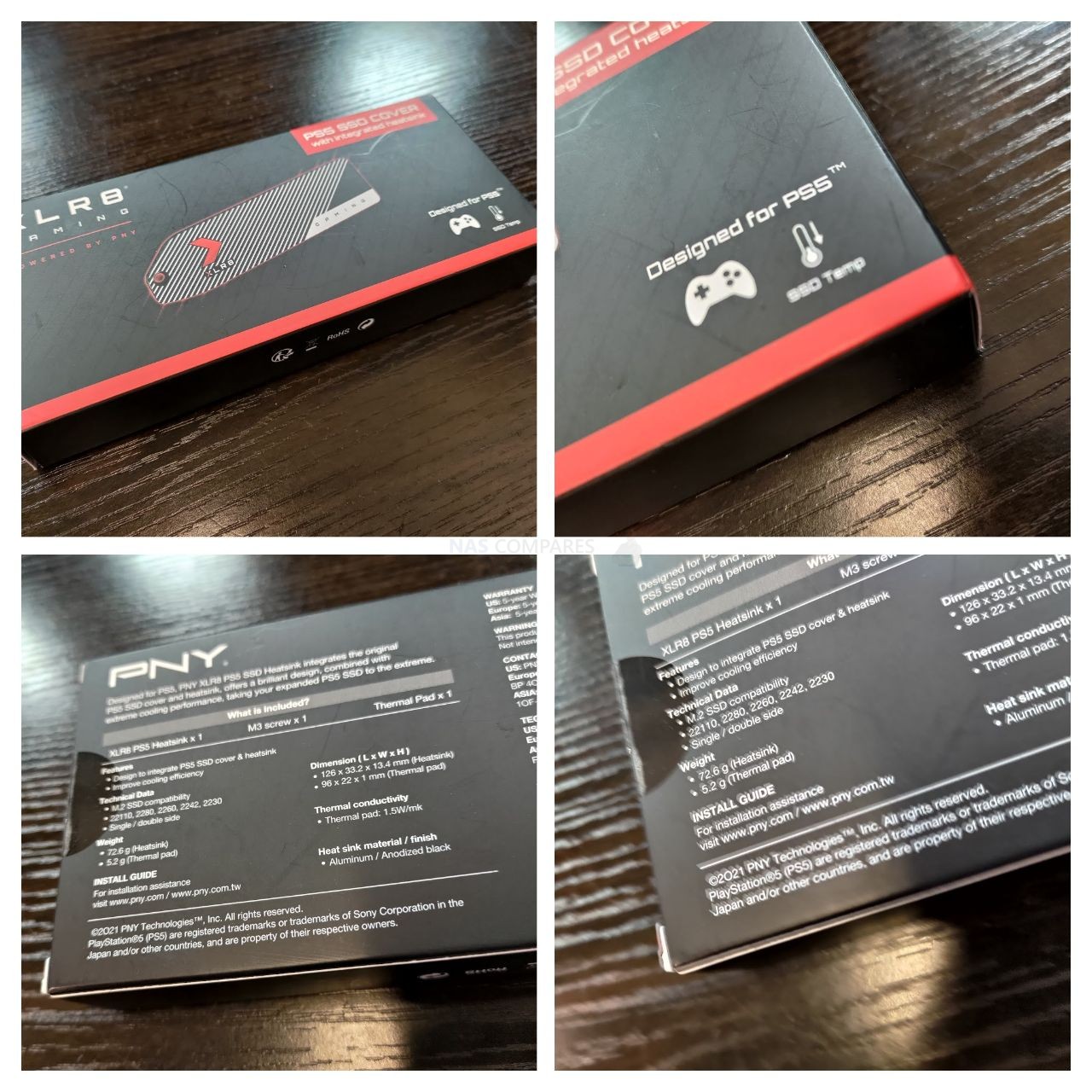
Using the familiar livery of their XLR8 professional gaming brand, if we open up the retail box, we find that inside contains a rigid foam frame holds both the PNY XLR8 PS5 SSD Heatsink and an m.2 screw in place. There are no additional instruction manuals present, though details of installation are covered on the rear of the box.
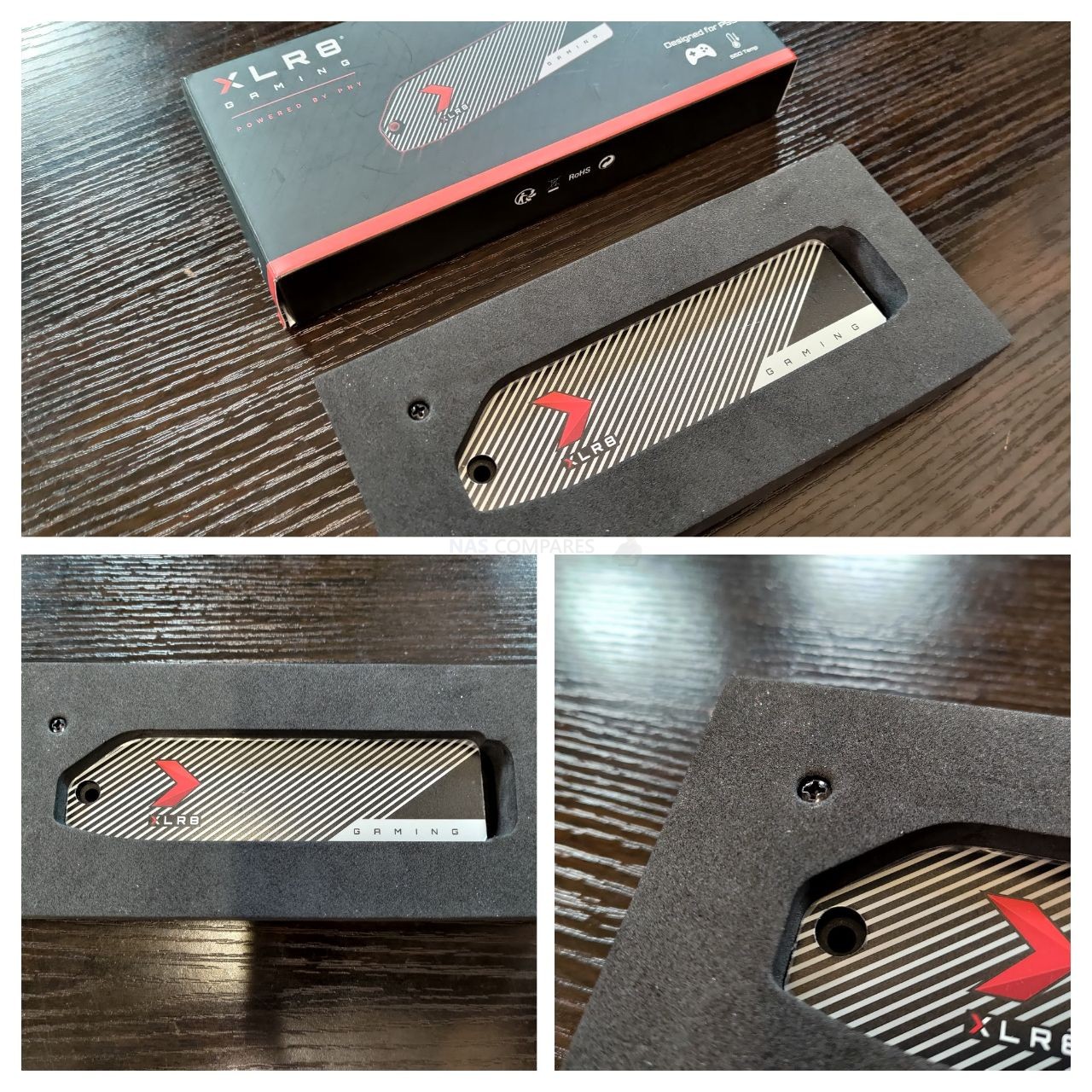
The PNY XLR8 PS5 SSD Heatsink arrives with a preattached thermal pad on the base of the aluminium plate, which turns out is a pinch thicker than the typical pads we see with these heatsinks. It is a shame that this heatsink does not feature an additional thermal pad for the underside of an installed SSD, but given that the base of the SSD typically only has further NAND and perhaps 50% of the memory, these components can actually run better when they are a little warmer. Additionally, when deployed onto an SSD, the thermal pad made full contact with the SSD components (ink tested).
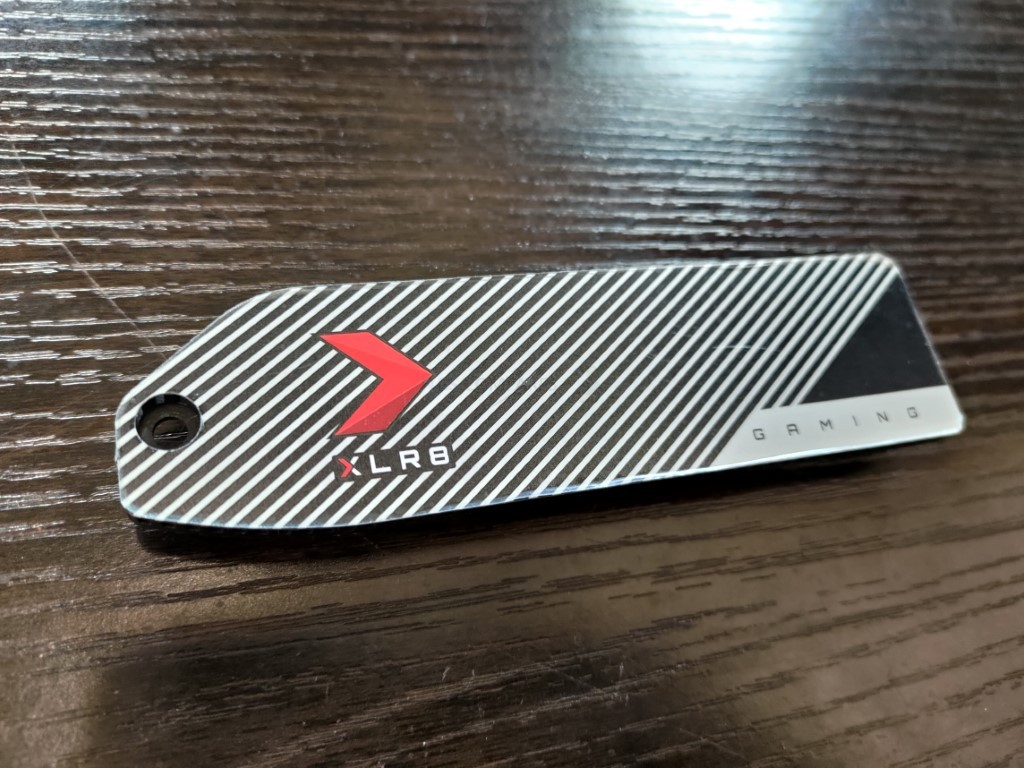
PNY XLR8 PS5 SSD Heatsink – Design
The design of the PNY XLR8 PS5 SSD Heatsink is something that I think puts it high above its competitors in terms of aesthetics and appeal. Given that this heatsink is going to be largely unseen when it is doing its job, it does look remarkably pretty! Arriving with the XLR8 gaming livery once again, it has a design that leans a little towards F1 racing cars and gaming laptop chic. With the logo highlight visible, as well arriving in a colour scheme that is a cut above the usual dull black or silver that 99% of other heatsinks arrive in. Again though, this is still a component that is going to only be seen during installation, then largely invisible afterwards.
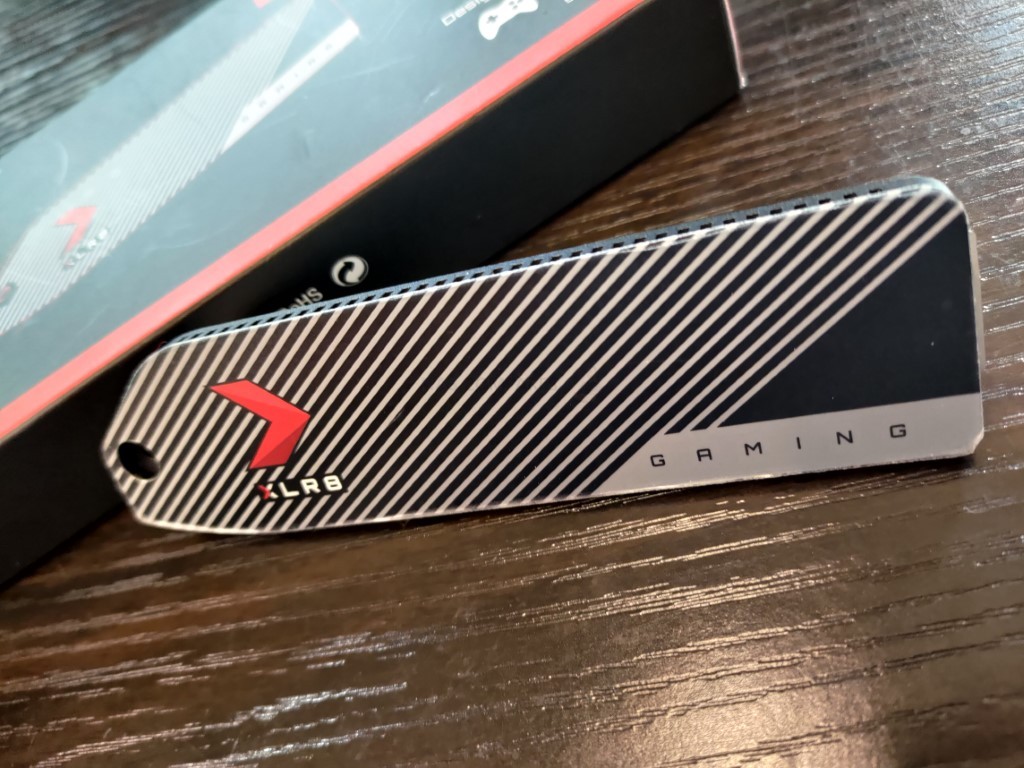
One interesting thing to note though (and something that many will have missed when PNY first showed this heatsink off on its official site) is that although it looks like the top of the PNY XLR8 PS5 SSD Heatsink is ridged (appearing very similar in physical design to the Sabrent PS5 SSD heatsink), that top panel is actually flat/flush, without the logo being embossed/raised either.
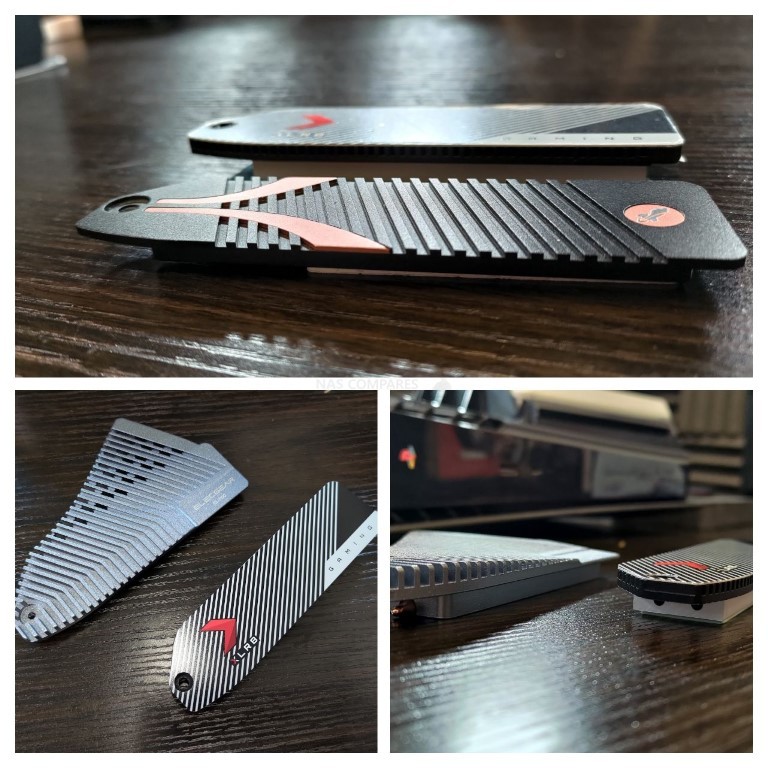
In fact, it is only when you view the PNY XLR8 PS5 SSD Heatsink at an angle that you notice that the heatsink has many, many raised ridges to capture airflow through the PS5, BUT they are covered by that top panel. Now, this is an unusual move for a heatsink, given that the main advantage for a heatsink to occupy/sit-above the PS5 M.2 slot, is so it can capture the airflow of the console’s from vents, as the system pulls air in and then out the back of the chassis.
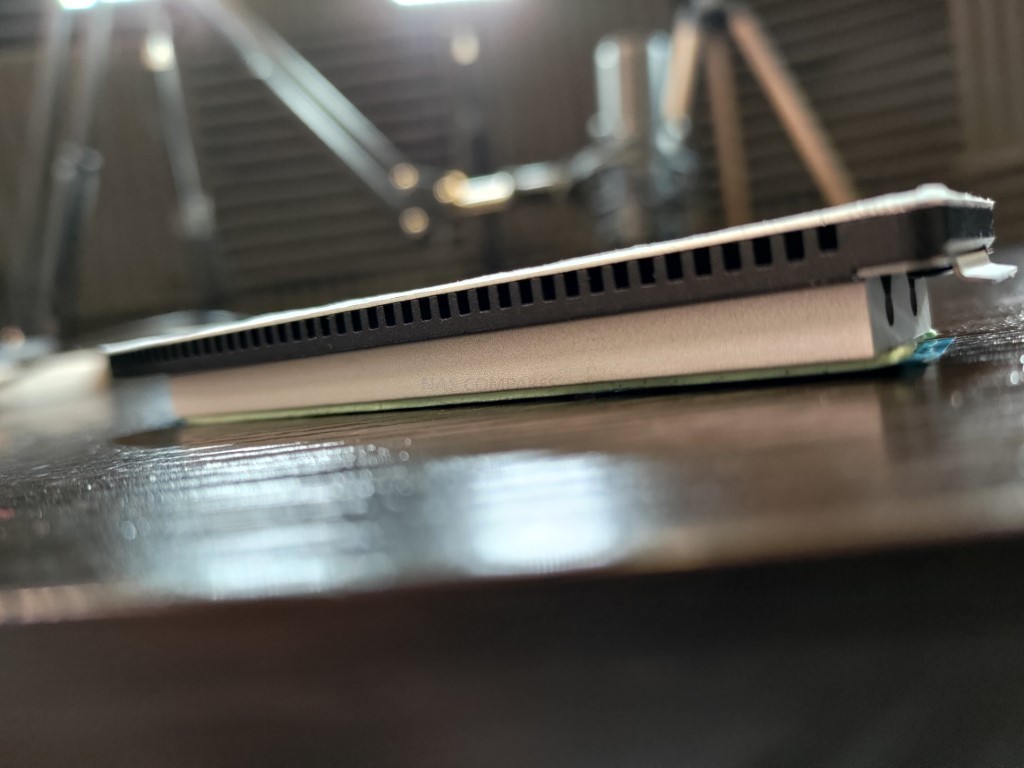
The PNY XLR8 PS5 SSD Heatsink certainly fully occupies the PS5 M.2 slot, as well as raises out of the available bay a few millimetres, so it is capturing that air to assist SSD dissipation as you would hope. Nevertheless, this is a very discrete bit of design/airflow that you would not expect and whether this is for reasons of avoiding introducing warm air into the console OR for reasons of patent/design uniqueness – it is hard to say. I will say that compared with the Sabrent H/S and Elecgear SSD heatsink‘s reviewed previously, the PNY XLR8 PS5 SSD Heatsink will almost certainly have the lowest impact on the system general temperature.
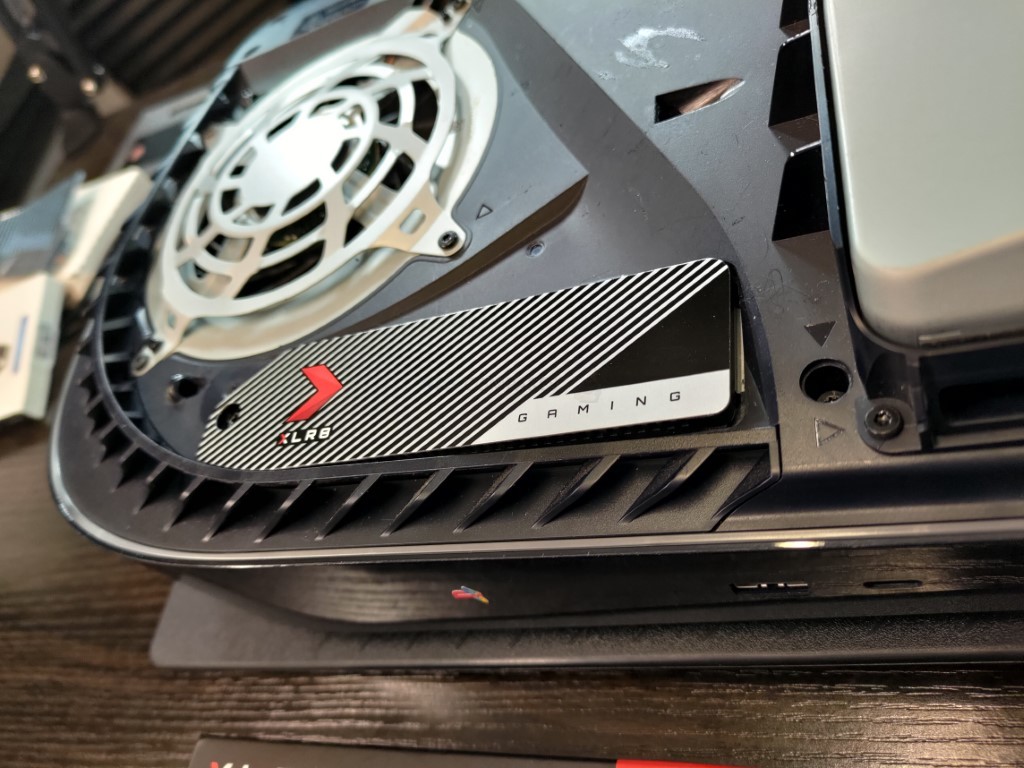
Another interesting element is that the PNY XLR8 PS5 SSD Heatsink occupies the full length of the PS5 22110 m.2 slot. The bulk of modern M.2 NVMe SSDs are 2280 in length, but the PS5 arrives with the longer 22110 SSD support (which is arguably a bit wasted, given the PS5 has a maximum capacity of 4TB supported in this m.2 slot) and if you were to install a longer SSD in this slot (perhaps so you could get an SSD with a better distribution of NAND chips on it’s physical PCB to improve performance and/or durability), then having a heatsink that can amply dissipate heat from even the larger SSDs in the market is going to be a good thing.
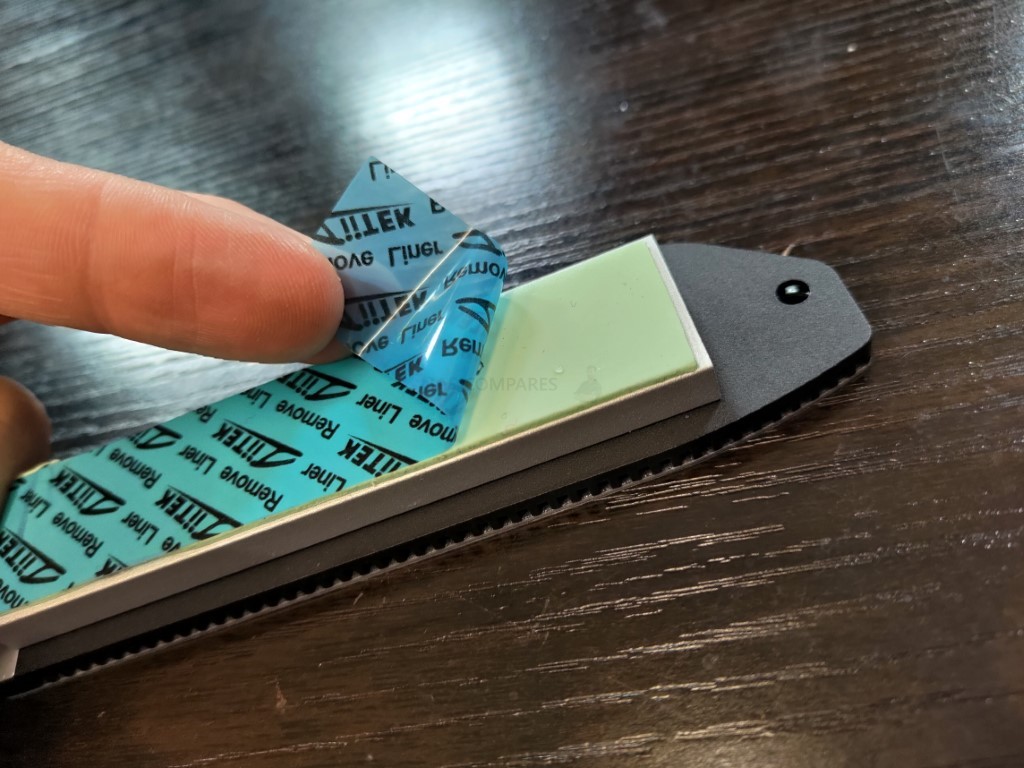
The PNY XLR8 PS5 SSD Heatsink fits on top of the SSD in a much similar way as the official M.2 expansion cover plate, with a lever hinge at its base that allows you to lower the heatsink over the SSD and the screw hole will perfectly align with the one on the PS5 (you will need to reuse the official screw that features the square, triangle, circle and cross symbol).
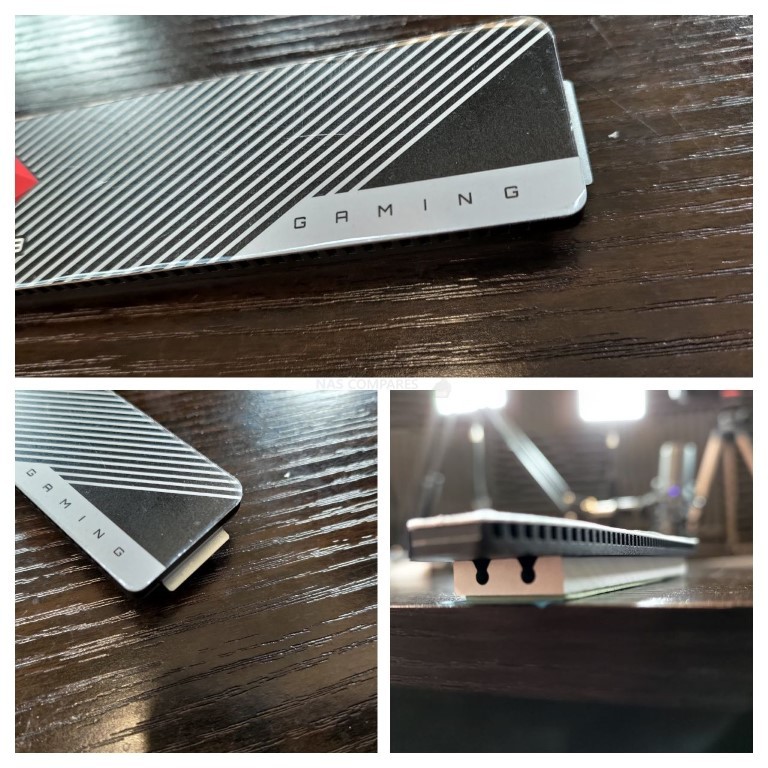
In short, it is very hard to get this wrong! The SSD cannot be damaged in this installation and the lower, protruding aluminium 22110 length area of the heatsink will always make contact with the SSD.
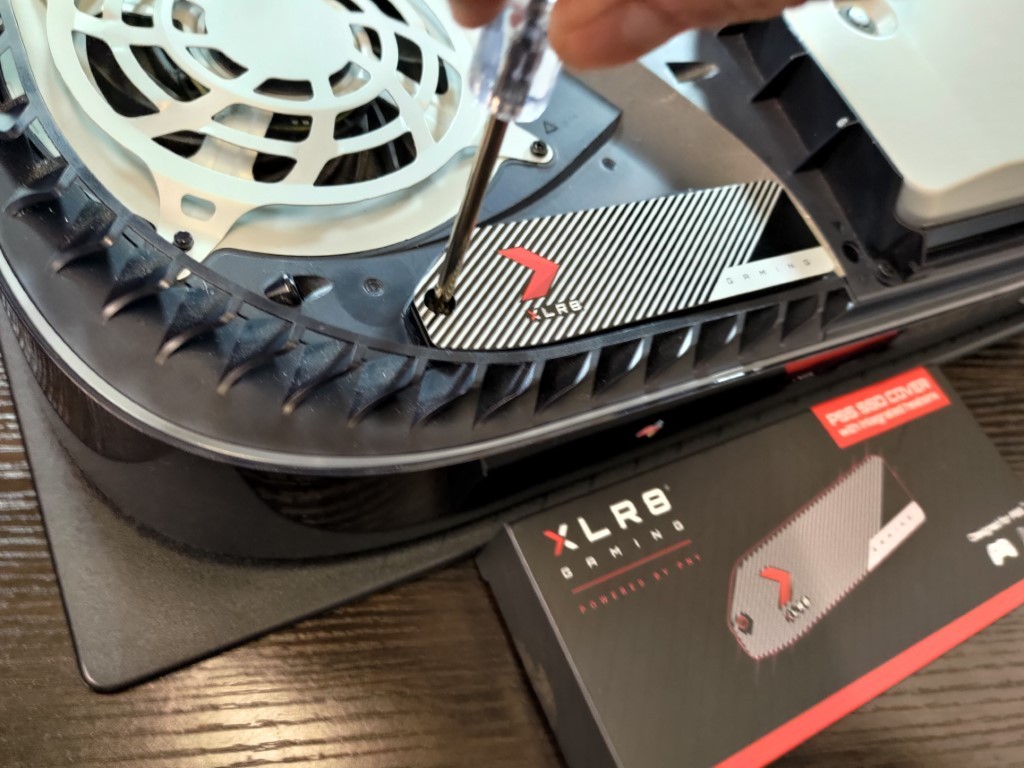
The heatsink, once installed, will make zero contact with the PS5 side plates and although the aesthetic design of the PNY XLR8 PS5 SSD Heatsink doesn’t quite look as uniform as the Sabrent H/S and Elecgear SSD heatsink, It still looks rather easy on the eye. Next up, we need to do some temperature testing of the PNY XLR8 PS5 SSD, see how it compares against budget $10 heatsinks for PC and whether it negatively impacts the ambient airflow of the PS5 when in use.
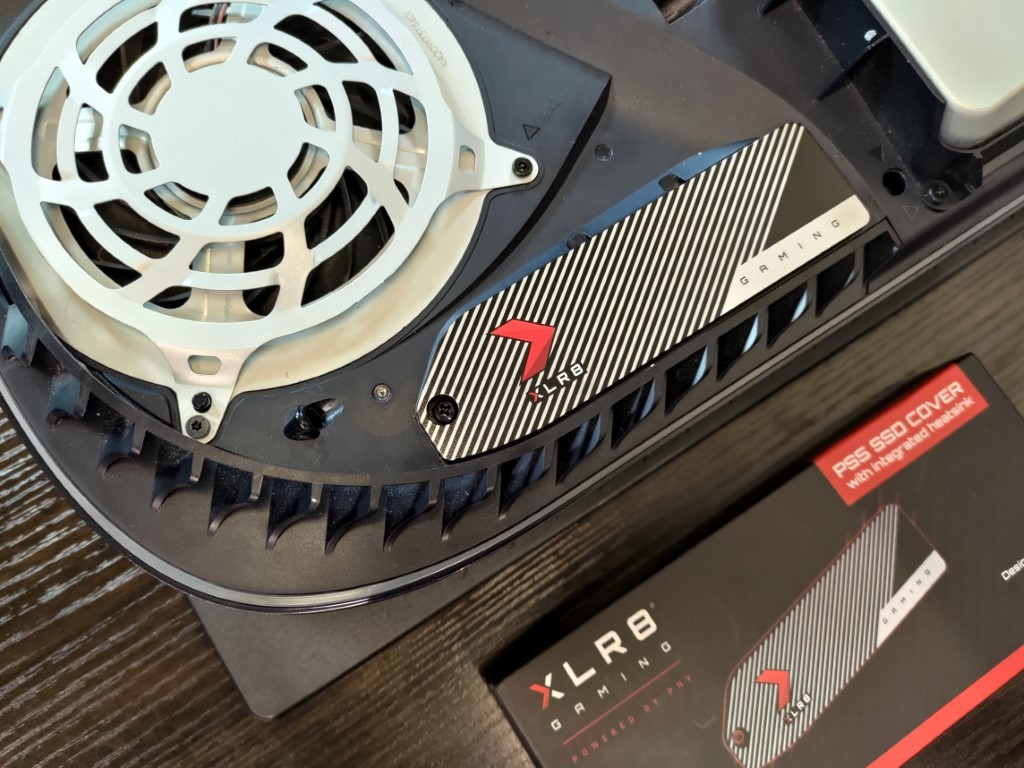
PNY XLR8 PS5 SSD Heatsink – Temperature Tests
IMPORTANT – Temperature Testing is still IN PROGRESS and although early testing clearly indicates that the PNY XLR8 PS5 SSD Heatsink works very well, the FULL details, readings and results in comparison with a generic M.2 SSD heatsink will be updated in this article in the next few days when the test stages are completed. Apologies for the delay.
Temperature testing for the PNY XLR8 PS5 Designed SSD heatsink has been broken down into several areas. The main aims here are to work out the following things:
- Does the PNY XLR8 Heatsink Keep the Temperature low on the SSD in sustained use?
- Does the PNY XLR8 Heatsink Interfere with the PS5 Internal System Temp negatively?
- Does the PNY XLR8 Heatsink provide a significant improvement over PC designed M.2 SSD heatsinks (eg the Eluteng M.2)
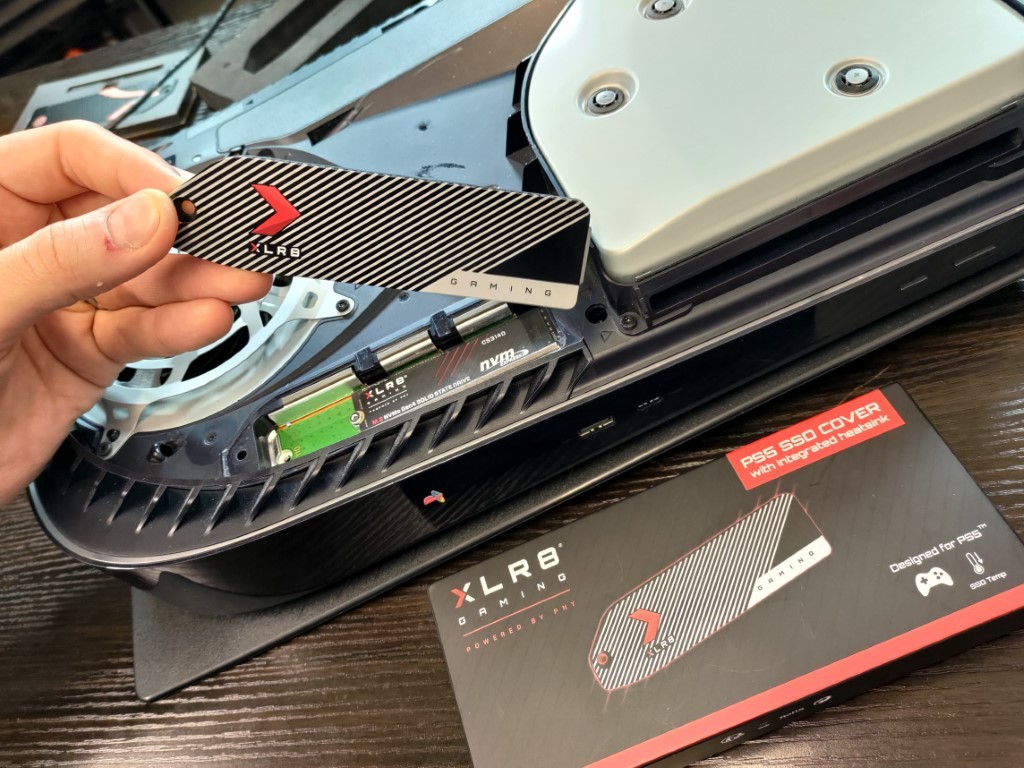
In order to do this, I have installed a temperature sensor on the M.2 SSD itself, UNDER the heatsink AND the thermal pad, directly on the controller chip of the SSD.
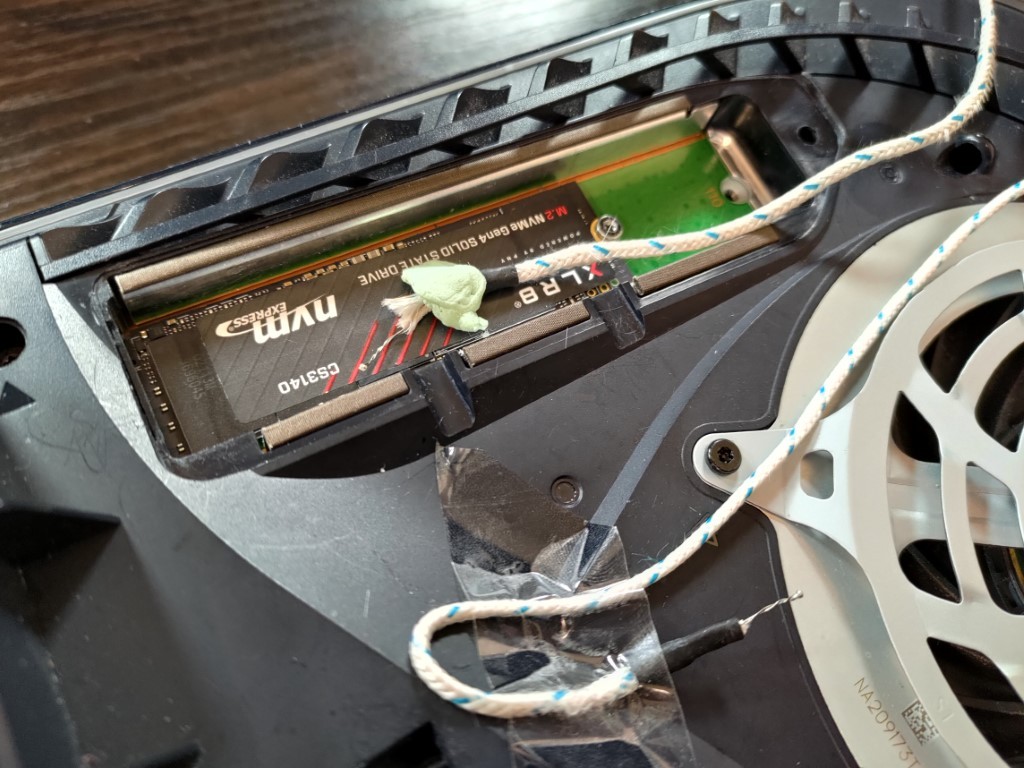
When the temp node is on the SSD Controller, I then place the thermal pad down, closed and screw down the heatsink, then attach the 2nd node just underneath the PS5 fan point, in the open air. This second temperature sensor will tell us the surrounding system temp that the internal fan will be used to cool the rest of the system.
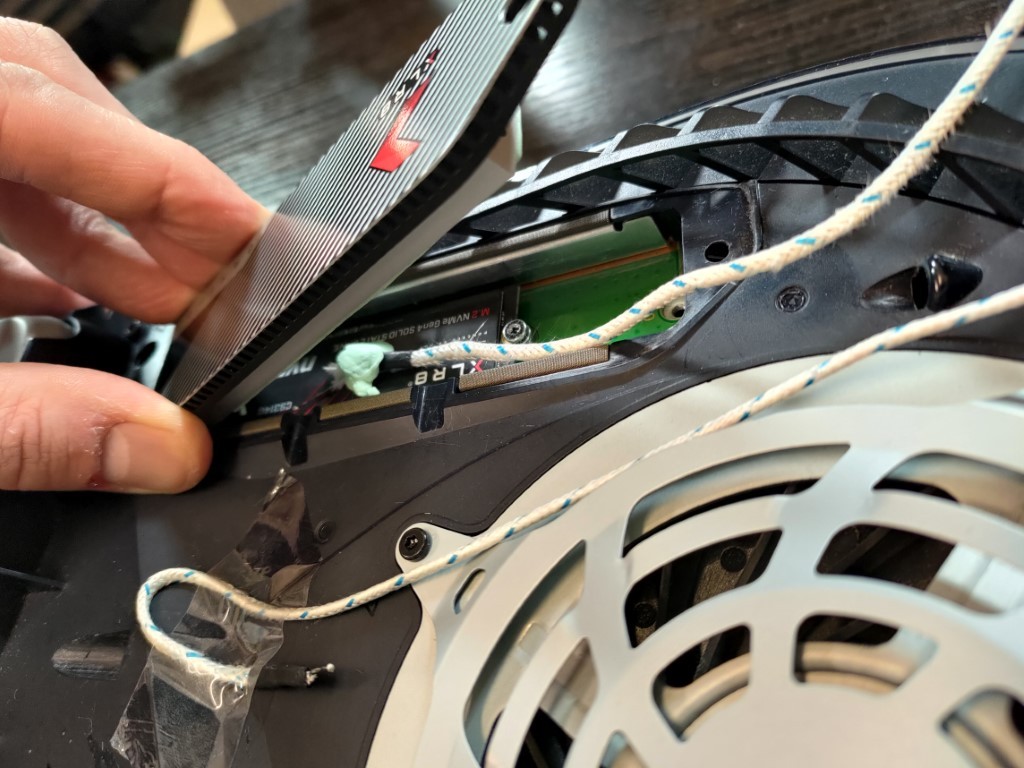
The testing consisted of 6 different elements. 4 gameplay sessions of 25mins each, with 2 sessions focusing on the SSD temp and 2 focusing on the system temp (in that order, with 1-2 mins reboot between each, in order to see how the system temp is affected over the combined power-on time).
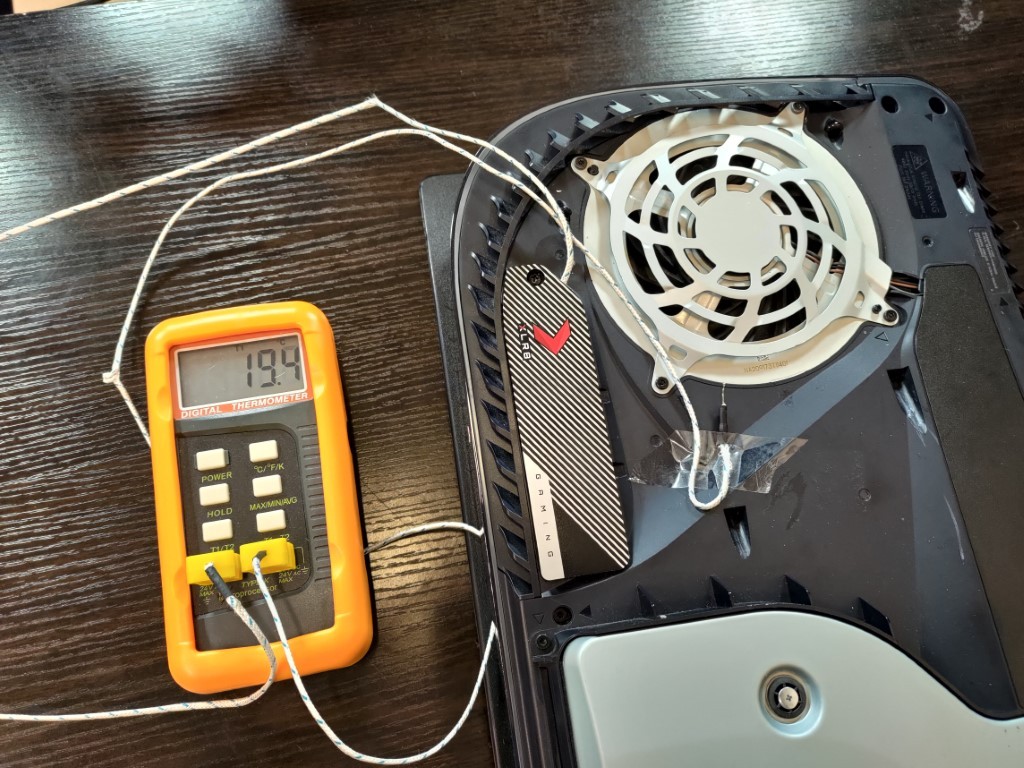
Then a sustained read and write activity of 350-380MB/s to/from the PS5 internal PS5 SSD and M.2 NVMe SSD (the tests were conducted with the PNY CS3140 2TB) and how it impacted the SSD controller only. We are NOT looking at performance/framerate/MB/s etc, ONLY temperatures. Below were the results (video will be published shortly).
Note – BOTH PS5 Side plates were on during the tests
 |
|||
| Test Type | Starting Temp (C) | Finishing Temp (C) | Change (C) |
| Heavy Write (350GB) | 18.7℃ | 26℃ | 7.3℃ |
| Demon Souls 25min Play (Controller) | 25.8℃ | 29.9℃ | 4.1℃ |
| Demon Souls 25min Play (System Temp) | 24.5℃ | 25.5℃ | 1℃ |
| Matrix Unreal 5 25min Play (Controller) | 27.9℃ | 35.1℃ | 7.2℃ |
| Matrix Unreal 5 25min Play (System Temp) | 27℃ | 28.5℃ | 1.5℃ |
| Heavy Read (350GB) | 25.2℃ | 29.5℃ | 4.3℃ |
As you can see, in almost all tests, the PNY XLR8 PS5 Designed SSD heatsink results in very, VERY small increases in temperature over time, much, MUCH lower than most of the other heatsinks that I have tested. To put that into perspective here is how this PS5 styled heatsink compared in those same tests versus the Eluteng M.2 at just $10 (at least $15 less than the PNY XLR8 H/S):
NOTE – There tests were performed on different days and ambient temp AND general environmental conditions can undermine these results. Watch the video published soon to see these results in much, MUCH greater detail)
| Test Type | Eluteng H/S Change | PNY XLR8 H/S Change |
| Heavy Write (350GB) | 15.1℃ | 7.3℃ |
| Demon Souls 25min Play (Controller) | 23.3℃ | 4.1℃ |
| Demon Souls 25min Play (System Temp) | 0.5℃ | 1℃ |
| Matrix Unreal 5 25min Play (Controller) | 16.3℃ | 7.2℃ |
| Matrix Unreal 5 25min Play (System Temp) | 1.8℃ | 1.5℃ |
| Heavy Read (350GB) | 18.8℃ | 4.3℃ |
So, as you can see, it certainly did a great job. These are still very small differences though and it is worth remembering that an NVMe SSD is designed to run perfectly well at between 30-50 degrees. Anything higher than that (headed towards 70 degrees) can result in throttling. Overall I still think the PNY XLR8 definitely does exactly what it says it will and does it very well – it is a question of whether you play your PS5 for long enough /regular periods that you need that level of protection/cooling. Let’s conclude the review and give my verdict.
NOTE – The FULL video of the Temperature tests for the PNY XLR8 PS5 Designed SSD Heatsink, as well as how it compares against the Eluteng M.2 Heatsink, the Sabrent PS5 heatsink and the PNY XLR8 Heatsink Heatsink is available soon.
When I previously compared the INEO / Graugear PS5 Hetasink against the Sabrent, Elecgear and Eluteng Heatsink, the main takeaway was that enterprise PS5 heatsink’s like these DEFINITELY keep the SSD/Controller much cooler, as well as have minimum impact on the system temperature too. The PNY XLR8 PS5 Heatsink can be compared easily against the Sabrent model and much like that model, unless you are a particularly hardcore gamer, the 3-4x price point of these prosumer copper pipe SSD heatsink’s are a little unnecessary.
PNY XLR8 PS5 SSD Heatsink – Conclusion & Verdict

The PNY XLR8 SSD heatsink for PS5 cannot really be faulted! There have been quite a few PS5 designed heatsinks released in the last few months and for the most part, they fall into two categories. There are the ‘overkill’ ones which sadly make up the bulk of them (such as the INEO, Graugear and ElecGear) that do the job, but at a high price tag, still require SSD research and unless you are an e-sports or heavy gaming streamer, as never going to even come close to their full utility (think of driving a Ferrari to pop to the corner shop for bread). The other PS5 designed SSD heatsinks like the Sabrent and the PNY XLR8 in this review very much fall into a smaller but much, MUCH more desirable category. The PNY XLR8 finds an impressive middle ground between keeping your PS5 SSD at an ideal ongoing usage temperature, whilst keeping a low profile and not interrupting the airflow/air temp that is running through the rest of the PS5 cooling system. Add to this the ease of buying in together with your PNY XLR8 PS5 compatible SSD and what you have here is an affordable and effective means to store more games, play for longer and maintain the lifespan of your SSD longterm. It may seem the pinch more expensive than a regular M.2 heatsink, but it’s about having the right tool for the job – have you ever tried spreading butter with a steak knife? Or stirring soup with a teaspoon? The same applies to comparing a PS5 designed heatsink with a PC designed one, they are both heatsinks, but for very different deployments. It get’s my vote!
| PROS of the PNY XLR8 PS5 SSD Heatsink | PROS of the PNY XLR8 PS5 SSD Heatsink |
|
|
🔒 Join Inner Circle
Get an alert every time something gets added to this specific article!
This description contains links to Amazon. These links will take you to some of the products mentioned in today's content. As an Amazon Associate, I earn from qualifying purchases. Visit the NASCompares Deal Finder to find the best place to buy this device in your region, based on Service, Support and Reputation - Just Search for your NAS Drive in the Box Below
Need Advice on Data Storage from an Expert?
Finally, for free advice about your setup, just leave a message in the comments below here at NASCompares.com and we will get back to you. Need Help?
Where possible (and where appropriate) please provide as much information about your requirements, as then I can arrange the best answer and solution to your needs. Do not worry about your e-mail address being required, it will NOT be used in a mailing list and will NOT be used in any way other than to respond to your enquiry.
Need Help?
Where possible (and where appropriate) please provide as much information about your requirements, as then I can arrange the best answer and solution to your needs. Do not worry about your e-mail address being required, it will NOT be used in a mailing list and will NOT be used in any way other than to respond to your enquiry.

|
 |
ZimaOS is the BEST Beginner NAS OS - Watch Your Back UnRAID and TrueNAS !!!
30TB Hard Drives are TOO BIG ! (and here is why)
COMPLETE UGREEN NAS Setup Guide - 2025 EVERYTHING VERSION
$110 USB4 to 2x10Gb Adapter Review - What the WHAT?
UGREEN NAS Now has iSCSI, 2FA and Jellyfin (and more) - FINALLY!
Seagate 30TB Ironwolf and EXOS Hard Drive Review
Access content via Patreon or KO-FI







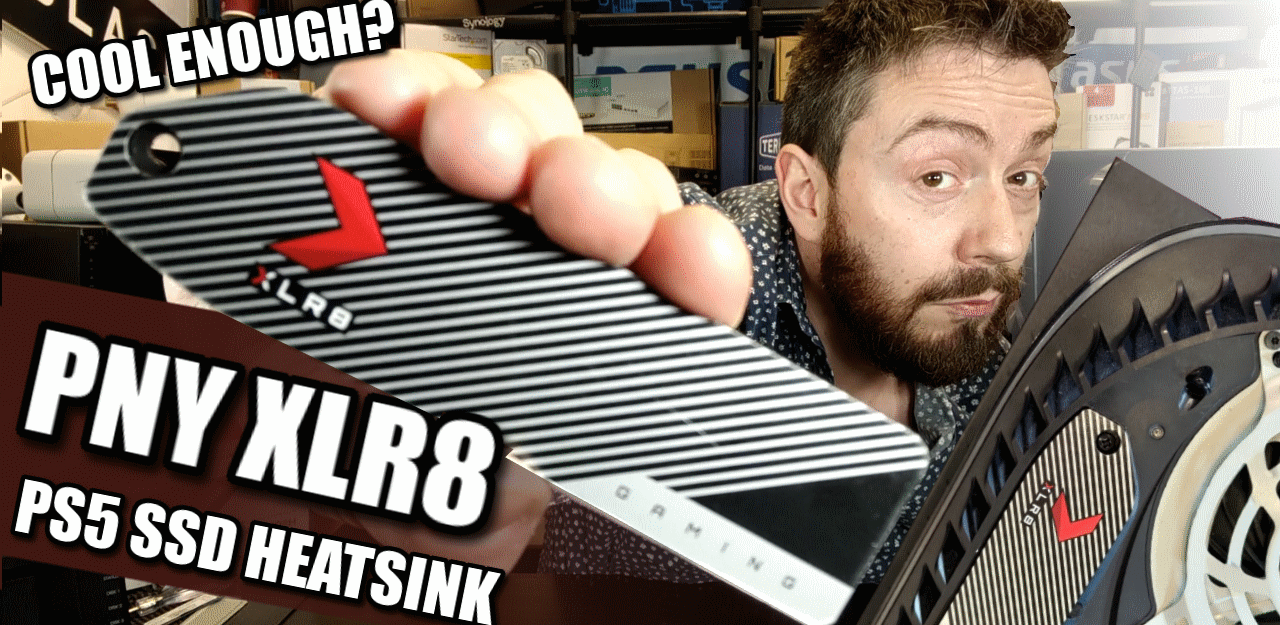




What is the ranking worst to best?
REPLY ON YOUTUBE
Which one fits in the ps5 slim?
REPLY ON YOUTUBE
Dont waste your time on the Elecgear style coolers if you have a 4tb ssd these styles will NOT fit.
REPLY ON YOUTUBE
Which of these work for the 2023 ps5 slim?
REPLY ON YOUTUBE
U talk to much
REPLY ON YOUTUBE
Is it really worth forking out extra money for different thermal pads than the ones that come with the elecgear??
REPLY ON YOUTUBE
Thank you.
REPLY ON YOUTUBE
if you really wanted to push these the eikon fights from ff16 had my ps5 working hard. After watching this I feel better about spending $30 on the elecgear.
REPLY ON YOUTUBE
Do I need to remove the warranty sticker on the top of m2 ssd to obtain a good contact between the ssd and heat sink
REPLY ON YOUTUBE
Just installed this in my slim ps5. It is so thick that the cover dont fit perfectly anymore
REPLY ON YOUTUBE
Nas would love to see more content like this alongside how you did the tests especially for the separate heat sinks with the plate on or how we can check temps ourselves. Curious to even if updates to SSDs via PC then installing into the PS5 and not formatting would make any impact to read writes and performance etc
REPLY ON YOUTUBE
So much talking so annoying
REPLY ON YOUTUBE
Hello..i want buy ssd for ps5. But don’t know which better between PNY and Adata XPG .
REPLY ON YOUTUBE
just bought it together with patriot vp4300 lite 2 tb, the default ps5 cover screw couldn’t actually screw the heatsink, i had to use the screw that came with this heatsink to be able to screw the thing itself to the ps5
REPLY ON YOUTUBE
Great video!
REPLY ON YOUTUBE
Will the sabrent heatsink and cover combo work with a fire cuda 530 ?
REPLY ON YOUTUBE
How does this compare to the Graugear cover?
REPLY ON YOUTUBE
Can I install the ElecGear heatsink on top of the Seagate FireCuda 530 built-in heatsink model?
REPLY ON YOUTUBE
Question can you put an elecgear heat sink ontop of a seagate firecuda 4TB with a heat sink into a PS5
REPLY ON YOUTUBE
Is it possible to change the thermal pad?
REPLY ON YOUTUBE
Is there a possibility to install a better thermal pad? For example the Thermalright Thermal Pad 0.5mm 12.8 W/mK?
REPLY ON YOUTUBE
Elecgear foor looks n cool.
REPLY ON YOUTUBE
Hello NAS, Thank you for the video
I wanted to ask if this Heatsink can be mounted on a MSI SPATIUM M480 or not.
Thank you.
REPLY ON YOUTUBE
Should I use gelid 1mm or 1.5mm thermal pad with the firecuda 530 2tb and elecgear heatsink
REPLY ON YOUTUBE
Hi need help , i have samsung 990 pro ssd , and looking for best heatsink, on 990 pro extremely high temperature, so need best heatsink , elecgear must be okey for me ?
Kind Regards,
REPLY ON YOUTUBE
Which is the winner at the end?
REPLY ON YOUTUBE
The Elecgear is so well designed, the lowest temps for electronics win the game of longevity ????
REPLY ON YOUTUBE
Wasn’t the clear winner the Elecgear as it’s average temps were much lower than the other heat syncs? I realize that he said ambient exterior temps varied based on where he lives but the Elecgear was so much cooler than the others.
REPLY ON YOUTUBE
Should be noted the PNY heatsink won’t fit the digital edition ps5 as it doesn’t have the extra clearance for the panels. Also with the PNY XLR8 CS3140 being double sided, shouldn’t there at least be a heatsink bottom for it? My the bottom half of a cheaper heatsink will do with one of these alternative heatsink PS5 bay covers??
REPLY ON YOUTUBE
I like your ps5 design ????
REPLY ON YOUTUBE
I just got the elec gear for my ps5 and I will have you know the box and packaging of it has changed from your written synopsis and is much better in that term now
REPLY ON YOUTUBE
The absolute worst kind of video cause you won’t show us what they look like in PS5, even for 10 seconds. Sorry, but this is beyond irritating.
REPLY ON YOUTUBE
Is it necessary to have the ssd backside heatsink?
REPLY ON YOUTUBE
Did this need to be 20 minutes ?!
REPLY ON YOUTUBE
How’s the durability of Sabrent? This is important to me cuz I expect them to last for years
REPLY ON YOUTUBE
i highly appreciate your videos that cover PS5 SSD temps and Heatsink temps.
however i couldn’t ignore that you are conducting these tests wrong.
you are measuring the starting temperatures with the ending temperatures, completely ignoring the ambient temperatures in the room.
in a real world scenario the ambient temperature in the room plays a very significant role for heat dissipation.
so in all of these tests you should’ve actually compared the temperature rises minus the delta temperature to see the ACTUAL temperature of the die.
for example, if a room temperature on one test is 20c and the SSD’s temperature is 27c then we know we have a delta of 20c and the actual temperature of the die is 7c.
additionally, ambient temperature plays a HUGE role when it comes to negative pressure based cooling systems. if the air the system is pulling is from a room with an ambient temperature of 25c than the cooling efficiency of the system would be greater than if the system is pulling air from a room with an ambient temperature of 32c.
since you didn’t mention the actual ambient temperature in the room for all of your tests than unfortunately your way of measuring dissipation in these tests are invalid.
in reality it does not matter how much heat the heatsink is able to dissipate, what actually matters is what is the actual temperature of the die minus the ambient temperature.
and in all of these tests the Elecgear is the clear winner.
however even my assumption that the Elecgear is the clear winner is a very educated guess because you provided no info regarding what was the actual ambient temperature in the room.
in the end you shouldn’t really care at how well a heat sink dissipates heat, you should care at how low can it keep temperatures – usually more surface area = larger surface area to dissipate heat = significantly lower temperatures.
the INEO could’ve been a better option, maybe even the best option had it used the same system as the Sabrent of attaching to the SSD. because the INEO has a very very low surface area and its core is a very small heat block than obviously anything that is bigger than it would dissipate heat better.
i think you should re-do these tests sometime in the future and score based on temps against ambient temps instead.
but overall this still helped me decide that the Sabrent i have right now is mediocre at best and that the Elecgear is worth its penny (especially now when they are not rare to find and cost around half of what they used to 8 months ago)
REPLY ON YOUTUBE
Iii il
REPLY ON YOUTUBE
‘
REPLY ON YOUTUBE
Il
REPLY ON YOUTUBE
I know I’m late to the party here but the Ambient Room temperature on each day of testing should have been included just for information purposes. People see lower numbers on screen and automatically think it’s the best. I understand your testing is to see the differential but not knowing the actual room temperature when each test was conducted is a bit of a misnomer. The Elecgear had the lowest overall temperature during each test but what was the room temperature when testing was performed? 18C? 20C? 22C? Great video and very informative nonetheless but in the future, it would be nice to include the ambient room temperature too.
REPLY ON YOUTUBE
Hi. I do not know English. Can you please tell me what is the optimal heatsink for ps5? wd sn850. to cool the ssd itself and not to heat the system.
REPLY ON YOUTUBE
Hi. I do not know English. Can you please tell me what is the optimal heatsink for ps5? wd sn850. to cool the ssd itself and not to heat the system.
REPLY ON YOUTUBE
The Elecgear seems the best out of themj all?
REPLY ON YOUTUBE
Hello, since i saw how you have tested the Heatsink of the PS5 i’m very insterested by your job.
Sorry if my English is not perfect. But your tests are a good idéa. Thank you and good continuation.
So whitch thermal device is the best one for you ?
Thank you.
REPLY ON YOUTUBE
Well you just sold a heat sync for elecgear. Lol. I have been running a ” battleship ” heatsync similar to the top left one.
REPLY ON YOUTUBE
Dude that Ps2 style faceplate is amazing
REPLY ON YOUTUBE
Best performance for nvme SSD is between 30-40 degrees Celsius case closed Elecgear is the winner
REPLY ON YOUTUBE
Assuming you take the dbrand plates out of the equation…PS5 plates + SN850 w/ builtin hs + standard cover VS. PS5 + SN850 + Sabrent heatsink cover…which one wins? Has this comparison been done?
REPLY ON YOUTUBE
Yep. I can’t find this heatsink anywhere. Not even on the official site.
REPLY ON YOUTUBE
Would you take a ssd with heatsink like the WD_Black SN850 2TB or another SSD with the ElecGear Heatsink? What would be better?
REPLY ON YOUTUBE
This heatsink doesn’t fit on my ps5 digital version. The profile is too high. Could you please check that on your digital version as well? Also, is the disc version ps5 faceplate swappable to the digital? Thanks
REPLY ON YOUTUBE
Its available no where. Shame. Buying sabrent.
REPLY ON YOUTUBE
i want to see a base comparison with no h/s
REPLY ON YOUTUBE
Why can I not buy this in the states? Can’t find it online anywhere
REPLY ON YOUTUBE
I not understand… why you tell sabrent better if the eLecgear have the lower temperature in all the test…
REPLY ON YOUTUBE
If you have the firecuda 4tb with ekwb heatsink would it be better to change the heatsink to the ineo heatpipe or elecgear for long gaming seasons? If I followed your videos the other 2 heatsinks only drop the temps like 3 to 5 degrees?
REPLY ON YOUTUBE
Have you ever compared the temperature differences between using the Seagate Firecuda 530 including heatsink with the ssd bay cover versus Seagate Firecuda 530 using the PNY/Sabrent PS5 heatsink? I think that would be a very interesting experiment for those people that can only get the bare drive versions. Or any/all SSD’s that have variants with and without factory installed heatsinks. Love all these PS5 SSD test videos.
Also a heads up for anyone reading this, Amazon and a few other vendors have been selling the Adata XPG Gammix s70 Blade S70 (and full heatsink) for either $125-130 or $145-160 with a $20-29 discount coupon. There are also 2Tb models for $220-250 also with a discount coupon of $10-30.
REPLY ON YOUTUBE
Any thoughts about some complaints regarding the wd sn850 with factory installed heatsink, the thermal pads are not touching the chipsets?
REPLY ON YOUTUBE
Can you do some testing on the Kingston Fury Renegade SSD for PS5 by any chance? I’m torn between it and the Firecuda because their read/write speeds are identical to each other on paper, but the Fury Renegade oddly enough has a heat spreader attached and Kingston says that a heatsink isn’t necessary for it.
REPLY ON YOUTUBE
So the elecgear is always the better one ☝????
REPLY ON YOUTUBE
I’ve meant to ask what’s your quality standard you’re using for thermal pads? Some are much better than others apparently. It could be helpful for others maybe looking to duplicate your performance or decide they want better if cheaper pads are getting xyz result in these tests.
Also thickness for the pad used on the given ssd. I think for the folks new to this that information for those could be helpful. Just a thought for folks that want to copy and paste your set ups for the test.
For anyone reading I’m using an elecgear with Gelid Solutions GP-Extreme thermal pads with the thickness being 1.5mm and 1mm on a Firecuda 530 4tb.
REPLY ON YOUTUBE
Nas do you recommend putting a thermal pad on the bottom of the ssd when using the pny or Sabrent plates? I’m using the sn850 and it’s only a single sided nvme drive?
REPLY ON YOUTUBE
Where are these PNY XLR8 Heatsinks being sold in the USA? Will they be priced similar to the Sabrent model?
REPLY ON YOUTUBE
I got the Sabrent Heatsink. PNY is better? Should I change it?
REPLY ON YOUTUBE
as always great work and I appreciate all the work and time you put into your videos
REPLY ON YOUTUBE
I liked the elecgear to the sabrent and now pny for one reason. The ssd I bought was $900 (firecuda 4tb) and my ps5 is $500. If the ps5 dies it is substantially cheaper to replace lol
I have a feeling the pny will unseat the sabrent between the two of them
REPLY ON YOUTUBE
Can’t find the PNY Heat sink anywhere below plz please?
REPLY ON YOUTUBE
Hey I think it would be great if you documented all of your research and findings into a Google spreadsheet or something like that. And if you can’t. I understand that it takes a good amount of time to do that with all of your previous reviews on heatsinks and all of the different ssd,s that you can install in the ps5
REPLY ON YOUTUBE
I enjoy all the heatsink reviews thankyou, but is the best option to buy the SSD where the manufacturer has installed the heatsink at production. Or is it best to buy the SSD without heatsink and add a third party heatsink? What are your thoughts on this?
REPLY ON YOUTUBE
So PNY is equal or slightly better than the Sabrent, Will buy the cheaper option with Firecuda SSD.
I really want to wait for your big review but Horizon & Elden Ring are almost out and i want the best upgrades for preformance.
Thank you for your analysis.
REPLY ON YOUTUBE
Don’t understand your Elecgear critism.
Nobody had any issues with the heatsink and It achieves the lowest temperatures possible. It causes no harm to the PS5 system.
About the PNY It looks like it’s a little better than the Sabrent. They achieve the lower temperatures with their own special design. Problem of the PNY is the price and the availability.
REPLY ON YOUTUBE
Is this is heatsink actually out yet? I live in the US can’t find it anywhere for sale
REPLY ON YOUTUBE
First.????
REPLY ON YOUTUBE
When’s the comparison coming out?
REPLY ON YOUTUBE
Hey man, is ur testing coming yet? I really wanna know if it has better cooling than Sabrent PS5 ssd heatsink. If it has a lot more cooling than Sabrent, than I’m considering getting another one. plz finish ur video soon lol
REPLY ON YOUTUBE
I’m a little shocked there’s no PS5 games in the PS5 heatsink video.
REPLY ON YOUTUBE
Is this out yet? I can’t find and the website doesn’t work
REPLY ON YOUTUBE
Some of these look overkill as heck.
REPLY ON YOUTUBE
I cant find the link to buy one
REPLY ON YOUTUBE
JEYI Eagle heatsink, just saw a video, kinda remind me of the ElecGear heatsink.
REPLY ON YOUTUBE
Can we just get an answer about these type of ps5 cover heatsinks with the Gammix blade heat spreader please.
REPLY ON YOUTUBE
Looks like a direct copy of the Sabrent.
REPLY ON YOUTUBE
Found another new heatsink contender:
https://youtu.be/X2TTPfa8_fg
REPLY ON YOUTUBE
Thank you, I have a one of the $10 heat sinks you linked from Amazon from months ago. And I got a wd sn850 1tb stick Sunday. But this would be cool to upgrade for my ps5 for when I eventually get a 2-4tb stick.
REPLY ON YOUTUBE
OFFTOPIC
Hey can you test the read and write speed of the samsung 980pro with the new firmware update 4B2QGXA7? After the update the PS5 benchmark now shows 6500mb read speed on the ps5. A comparison with the old values and the wd and sabrent m2 Ssds would also be great.
REPLY ON YOUTUBE
Best channel on yt when it comes to ps5 memory and heatsinks (from what I watched so far) hands down! I appreciate your dedication!
REPLY ON YOUTUBE
Hey man , huge fan of ur work with the ps5 ssd and their heatsinks , i have a request that i think will answer a lot of questions , can u do a long session thermal tests , im talking about 3+ hours of gaming or close to that , to see how much will the heat raise up to and stop .
REPLY ON YOUTUBE
It’s it ok to use the SABRENT PS5 HEATSINK with the S70 BLADE HEATSINK (using both)
REPLY ON YOUTUBE
hey man i have the MHQJRH heatsink on my 980 pro , and i want an upgrade , would u recommend the Sabrent or the Elecger ?
REPLY ON YOUTUBE
what i would like to say can i put firecuda 530 2TB with sabrent heatsink? or I have to leave it with the original firecuda heatsink??
REPLY ON YOUTUBE
Are there any indications that a M.2 22110 ssd model for PS5 is in the works from any manufacturer? CES is this week so .. maybe?
People who purchased the PNY XLR8 CS3040 ssd are reporting that it only has a read speed of 3850 mbps..minimum required is 5500 mbps. Is the PNY ‘CS3140’ the M.2 ssd people should be buying instead for their PS 5 consoles ?
REPLY ON YOUTUBE
i don’t know why i keep watching these. i don’t even have a ps5. knowledge for the future i suppose.
REPLY ON YOUTUBE
I think you need to use PS5 games to test these drives. The games you use in a lot of your benchmarks are PS4 games running on a PS5 and they aren’t designed to take advantage of the SSD speeds of the PS5. The data streaming is a lot less than PS5 (current gen) only titles such as “Ratchet and Clank”, “Returnal” or even the Matrix unreal 5 demo.
REPLY ON YOUTUBE
Hi, I was using an Eluteng style heatsink but have swapped the top section and ps5 cover for the Sabrent heatsink leaving base of Eluteng in situ. Can you foresee any issues I may have?
REPLY ON YOUTUBE
Are these heatsinks easy to remove without damaging the ssd later if I’m perhaps looking to upgrade, because those thermal pads really stick to those things.
REPLY ON YOUTUBE
hi I have a 2 TB firecuda 530 with the heatsink that came with the package, is the heatsink okay or should I change it? I was undecided between the sabrent heatsink but I read that the 2 TB firecuda is not unilateral. A thousand thanks
REPLY ON YOUTUBE
It has the same engineer properties as a whistle I’m not an engineer but that’s what it looks like to me but that’s just my opinion
REPLY ON YOUTUBE
First of all, thank you so much for these reviews! I saw a youtuber, lately, talking about updating his Sansung 980 Pro to tave greater speeds. I would be very curious to have your thoughts on that. Happy 2022!
REPLY ON YOUTUBE
does it have built in heatpipes tho
REPLY ON YOUTUBE
I think the harmonica design would be pretty good for heat dissipation, but I’d definitely be worried about pressure on the SSD. I honestly hope for a heatsink that can sit on a heatsink equipped SSD for further cooling, but it might be a pipe dream.
REPLY ON YOUTUBE
It looks like a really good heat sink I wonder if it is very cool we won’t know until you test it
REPLY ON YOUTUBE
I love your optimisim about how you explain things on your videos, but I Hope you make a video as well that less than 8 minutes for fast facts, just maybe….
REPLY ON YOUTUBE
I have the Sabrent from release and it’s doing my SSD proud my ps5 is always quite so looking forward to your temp testing as I can defo see myself buying this and use the Sabrent as a spare as I have quite a few thermal pads spare, but for 20 something dollars is chump change to care for your SSD expansion bay
REPLY ON YOUTUBE
wow review with no data ! GJ im impressed !
REPLY ON YOUTUBE
This guy is telling the p n y x l r 8 3140 pretty hard… Don’t buy that solid state. I bought it thinking it was the cheapest drive that was gonna meet system specs because it says it gets 5600 mbps. I had to return it because that’s false advertising my playstation 5 read it at about 3200 Which is well below what you need I wound up returning it to Best Buy and getting the gamex S70 blade. It was $20 more and is advertised at 7400 And actually gets about 6300
REPLY ON YOUTUBE
I wish they came out with this when I purchased my xlr8 1tb ssd for the beta over this past summer, but I may get the cover for my ps5 digital
REPLY ON YOUTUBE
SSD makers really starting to find a niche here eh?
REPLY ON YOUTUBE
@NASCompares Although I have a tremendous amount of respect for this channel and what you are doing, I do think you and alot of people are overlooking the fact that the pressure from these type of heatsinks is bending the SSD downwards in the middle.
Elecgear understood that and that’s why they give you that piece of ‘supportive EVA foam’.
Now if you understand electronics, you would know that a bending PCB isn’t all that great for the soldering joints.
Anyway please bring this up in your video’s my guy. It’s easy fixable with some EVA foam like Elecgear does.
REPLY ON YOUTUBE
Great vid as always, can’t wait to see it compared to the sabrent heat sink
REPLY ON YOUTUBE
I’m looking forward to seeing how it performs, my only worry would be that the height of it restricts the airflow in too much and the affect that may have on the internal temperatures of the system even if it works wonders for cooling down the SDD.
REPLY ON YOUTUBE
If you already have a SSD with build in heatsink. Is it possible/necessary to put in a heatsink plate instead of the stock plate.
REPLY ON YOUTUBE
Excited to see how it will do against the Elecgear.
REPLY ON YOUTUBE
Please apple make a gaming console!! 4 1500.-
REPLY ON YOUTUBE
Cool
REPLY ON YOUTUBE
„I hate seagulls“ ????
No worries, they actually bring a nice background sound. Nice knowing you are streaming at a sea side.
REPLY ON YOUTUBE
can i use the sabrent heatsink with a 980 pro ?
REPLY ON YOUTUBE
i already have the Eluteng , should i replace it the sabrent heatsink ? or im i good ?
REPLY ON YOUTUBE
Great review. I got a 980 Pro with the Sabrent, because I can’t get the Elecgear in Europe ( if someone knows where please tell me ) .
As for the Sabrent heatsink, I noticed the thermal pads are not really making super contact … so I will swap them. Anyone here with the Sabrent that can give me a hint on what sizes to use on the thermal pads?
REPLY ON YOUTUBE
Always interesting to watch.Just a thought regarding the slightly higher temps for the ineo heatpipe,would you get lower ambient system temps if you covered up the gap that is left in the top of the ssd slot?This would in theory totally encase the slot.
REPLY ON YOUTUBE
Waiting for the serbrent 4 plus 4tb to drop in price paired with the elecgear after watching this ???????? was unsure on which heatsink like you said its not a PC ????????
REPLY ON YOUTUBE
2tb firecuda 530 and elecgear for me
*edit* went with a 4tb
REPLY ON YOUTUBE
And, VERY obviously, the ElecGear wins in every way you look at it.
The only interesting and deciding factors are:
1. Can the cooling solution prevent a “meltdown” under worst consitions. As you show, all tested solution can prevent this.
2. Semiconductors live longer the cooler they are operating. There is one solution that is “cooler” (whatever that actually means as far as thermodynamics is concerned) in every test.
Point 2. gives you the answer to everything you need to know.
Unfortunately, there is a third point that isn’t mentioned at all in the video. The point is:
Does the ssd device eventully fail because of r/w weardown, or does it fail because of thermals first? Even the cheapest solution is perfectly ok if the r/w weardown shows first. Obviously that is something you can’t really test within the time constraints you set yourself in.
And Pleeeeeeeeeeeeease: A test MUST always start at the same starting points. When you start your tests at wildly different temperatures, some of your conclusions (“its temperatures raised more”) are utterly meaningless.
REPLY ON YOUTUBE
Appreciate the tests. Though, in all honesty, I’m not sure if its worth getting anything more than that Eluteng (or equivalent oem), which can be found dirt cheap if you shop around. These consoles are mainly only used for reading content, so anything more its just plain overkill. The Eluteng is comparable to OEM coolers, and they don’t throttle in even the most poorly cooled of PC’s… I highly doubt you could even do that in consoles where its just used for playing games.
Cheers for the vids though, still super interesting to watch.
REPLY ON YOUTUBE
I kinda want the ElecGear!
Since it’s currently not available, I think I’m going with the Sabrent.
REPLY ON YOUTUBE
Love that retro ps5 skin you have definitely want one of my own.
REPLY ON YOUTUBE
If we wait another 6 months n continue to just use my external Hard Drive to transfer PS5 games I decide to play again a lot more options will be available n hopefully prices aren’t as much as the damn console itself
REPLY ON YOUTUBE
I would like to see if these bigger ssd heatsinks pre-heat the air that is going into the ps5.. If the cooler ssd causes the rest of ps5 to heat up, i would choose a hotter ssd (and cheaper heatsink too)
REPLY ON YOUTUBE
Can you confirm if any of these heatsinks are compatible with Gammix s70 blade with thin heatsink installed? Thanks!
REPLY ON YOUTUBE
This is really helpful Information, helps us prevent our expensive console from being permanently damaged from heat, but man, since when did gaming get this damn expensive just to have more storage space lol
REPLY ON YOUTUBE
just a curious question i’m sure others also thought about. what would happen if your ssd already comes with a heatsink but on top of that you use that sabrent heatsink cover or elecgear heatsink cover? will it run cooler or there will be no difference?
REPLY ON YOUTUBE
So what heatsink won?
REPLY ON YOUTUBE
Where can I get that dope black ps2 style font shell covering design for my PS5?
REPLY ON YOUTUBE
ok how did you ge that black faceplate and ps5 sticker
REPLY ON YOUTUBE
Hi! Thanks for the video, very informative and detailed, as always. Please could you give an advise on the thermal pads thickness you use? I think it would be useful for many. Just got my Firecuda 530 2tb and Sabrent heatsink. It seems like stock Sabrent thermal pad doesn’t fit tightly to the ssd controller. I’ve bought Thermal grizzly 3mm pad and it looks like it has tight fit on the controller and nands. Anyway, could you please give any recommendations on the pads manufacturer/model and thickness for users who have the same issue with the controller/nand thickness difference? Thank you in advance. ????
REPLY ON YOUTUBE
I bought the Firecuda 530 2TB SSD, and now have the Sabrent Heatsink… they work well with each other??
REPLY ON YOUTUBE
Sabrent heatsink it is i think this has the best price/value, every ps5 owner needs to watch this
REPLY ON YOUTUBE
This is starting to get hilarious, completely unnecessary heatsink designs, a simple heatsink will work just fine lmao. In fact, an SSD can even operate without the heatsink…
REPLY ON YOUTUBE
So what is the best ine
REPLY ON YOUTUBE
I have purchased Sabrent and using it with SN850. I think i will be just fine.
REPLY ON YOUTUBE
I love this content. Thank you. Would like to see a review and a heat test of a water cooled ps5 vs base ps5
REPLY ON YOUTUBE
Elecgear for the win, if you’re willing to pay.
Sabrent 2nd place, and decent price.
Don’t get the other two.
REPLY ON YOUTUBE
Sitting here watching these temps, rooting for my Elecgear like I’m betting in a horse race lol
REPLY ON YOUTUBE
Well now I’m truly conflicted own the sabrent and love it love the design and look of the elecgear they both work great don’t know what to do????
REPLY ON YOUTUBE
Elec gear seems like an easy winner, but any of these will get the job done easily.
REPLY ON YOUTUBE
Great video thanks ????????
REPLY ON YOUTUBE
Am I correct to say even the cheapest eluteng will operate within safe heat parameters. So it doesn’t really matter what you go for if you are price conscious eluteng will suffice?
REPLY ON YOUTUBE
Hi Nas can i use the Sabrent when using a ssd that already has a heatsink or is it one or the other.. cheers
REPLY ON YOUTUBE
Really enjoy watching your content. Always the right amount of detail i’m looking for.
I would highly suggest creating chapters/timestamps for your videos. Thanks and keep it up
REPLY ON YOUTUBE
I’m pretty satisfied with my sabrent heat sink, though I do like the look of the elecgear. I’m interested to see what other heatsink designs come out in the future
REPLY ON YOUTUBE
Great video!!, do you remember what thickness of thermal pads you used on the Elecgear since it provides a few options.
REPLY ON YOUTUBE
The fins on the eluteng are at 90 degrees to the airflow on the ps5 aren’t they?
They’re obstructing the exhaust without aerating the drive
REPLY ON YOUTUBE
If I were to apply a 1mm copper heatsink to a WD BLACK SN850 as if it were a XPG Gammix Blade with it’s 1mm heatsink and then use the Sabrent heatsink would that bring the same results as the elecgear or be overkill or harmful to the device and console?
REPLY ON YOUTUBE
Thanks for the video.
Did you say you can use the Gammix S70 Blade with its heat spreader and the Sabrent heatsink together, on another video…….or did I dream that? ????
REPLY ON YOUTUBE
I like the elecgear. It kept the overall temp the lowest. just my opinion
REPLY ON YOUTUBE
I bought the Sabrent and did tests compared to a Eluteng-type double-sided heatsink. Seeing how the Ineo and Elecgear did, I’m not changing since the results are not enough to make a difference to me – not to mention their higher cost. https://youtu.be/2hkNDJZuErs
REPLY ON YOUTUBE
I appreciate the work you did, but the temps you say and the temps showing are different. also, are the labels on the tests wrong? I had a hard time knowing the controller tests from the air temp tests.
REPLY ON YOUTUBE
Another fantastic informative video. Thank you
REPLY ON YOUTUBE
Thanks for putting up this video.
A minor flaw when it comes to conclusions/ table comparison on Sabrent Heavy Write temperature. It started at 31C @18:43 and finished at 40.9 C @21:03 , a rise of 9 degree.
Still, I’d agree to the conclusion to get either Sabrent or Elecgrar, both will serve just fine give the price delta.
REPLY ON YOUTUBE
I bet the new Ratchet and Clank would be a good SSD test
REPLY ON YOUTUBE
I play like 2 hours a day. I use the Sabrent Heatsink. Am I ok?
REPLY ON YOUTUBE
I’ve been waiting for this video to drop for so long.
REPLY ON YOUTUBE
I guess all these temps are totally fine for the SSDS right?
REPLY ON YOUTUBE
36 degrees is super good right?
REPLY ON YOUTUBE
I was waiting for this.
REPLY ON YOUTUBE
Well done!
REPLY ON YOUTUBE
Great video! In terms of performance not price, what heatsink would you personally go with?
REPLY ON YOUTUBE
Would be nice to see the elecgear with the firecuda 530 4tb vs the ek heatsink that comes with the firecuda ????????????????
REPLY ON YOUTUBE
I wonder how the DBrand Darkplate 2.0’s will affect these numbers with their fan cutouts… Any chance you have some ordered? Thanks for the info and thorough testing!
REPLY ON YOUTUBE
I would like to see this test done with the Darkplates V2. Since DBrand put a fan cutout on the sides of the plates, the fan may pull more air directly through the plate rather than over the heatsinks of the 3, that may change the results.
REPLY ON YOUTUBE
What really matters is the overall temperature difference,thus the Elecgear is the best by far…
REPLY ON YOUTUBE
After seeing this I think I’ll go for Sabrent SSD card plus the PS5 Heatsink, it looks like the best option for me.
REPLY ON YOUTUBE
Would you consider doing a test of them on the same day starting at the same time with multiple ps5’s? It would make it a more reliable comparison than different days with different ambient temperatures.
REPLY ON YOUTUBE
Sabrent PS5 wins and it makes for a very easy install as it comes with the screwdriver!
REPLY ON YOUTUBE
I’m not seeing enough to take my Firecuda 530 out to put a different heatsink on (Warship ProEletung style). I keep my room very cool (18-21c) so it will never go over 45c under heavy write or read so there’s no reason to change it out, especially with the longevity of the drive. Also the other heatpipes showed to increase PS5 system temps by several degrees and that is a trade off when anything under 50c is longterm stable for these SSDs
REPLY ON YOUTUBE
It would be nice to see a comparison between the included heatsinks vs. these aftermarket heatsinks.
For example: wd and seagate with their factory heatsinks vs. the same ssds with the sabrent and elecgear heatsinks.
REPLY ON YOUTUBE
At the write activity we see completely different numbers than what you say or what is written in the table at the end. For example, the sabrent had a delta of 10 degrees, but you say it had only 1 degree.
REPLY ON YOUTUBE
smashing ! 🙂
REPLY ON YOUTUBE
I think the Sabrent wins this. The controller temp change isn’t as great as the heatpipe, but outperforms the eluteng and is close to the elecgear. The average system temp change is 0.3, which is the best among the 4. Combined with the read/write heat handling, the Sabrent strikes a perfect balance between significantly cooling the SSD without raising the system temperature very much.
I’d really like to see these all tested with games developed for PS5 instead of PS4 games which may be making different demands of the SSD.
Edit: with @Must Try Harder’s correction, I think it goes from a win to a tie with the elecgear
REPLY ON YOUTUBE
You are always on top of the PS5 tech. I wanted the best and I’m glad I followed your advice and purchased the Seagate Firecuda530 and the Sabrent heatsink months ago. Thank you.
REPLY ON YOUTUBE
I use a be quiet MC1 heatsink for my WD 850 in the ps5.
The heatsink should be highly comparable to the Eluteng that was used for this test.
I think it’s totally fine for regular gaming usage and not necessary to switch to a sabrent.
REPLY ON YOUTUBE
That’s the comparison we were waiting for 🙂
Great work mate!
REPLY ON YOUTUBE
Elecgear is King.????????
What a beastsink.????
REPLY ON YOUTUBE
Can I combine any of these with the sn850 that already has a factory installed heatsink
REPLY ON YOUTUBE
I have the Elecgear installed. Very happy with it! My advice is too also buy some quality thermal pads. Gelid Solutions GP-Ultimate 15W/mk is a very good choice. ????????
REPLY ON YOUTUBE
Exactly what I was looking for! I’ve got the Sabrent but I’m seriously considering returning it for the Elecgear after seeing this. Appreciate the work on this!
REPLY ON YOUTUBE
FireCuda vs WDBlack 1st party heatsink, can you also add the gigabyte aorus 7000 as their heatsink one of the best.
REPLY ON YOUTUBE
got a bare firecuda 530 2tb for my pcie4 pc.
will you be doing a pc heatsink recommandation video? I just used the thermal guards on my aorus x570 pro and called it a day for now…
REPLY ON YOUTUBE
Thank you Robbie Andrews, you are the best youtuber of all time!
REPLY ON YOUTUBE
To put in simpler terms , i have the Eluteng , should i be worried ?
REPLY ON YOUTUBE
This video is so hot, we’re gonna need all of these heatsinks combined to cool off.
REPLY ON YOUTUBE
Thanks for taking the time to make this video!
REPLY ON YOUTUBE
This is the coolest youtube channel of all time!
REPLY ON YOUTUBE
I have a Sabrent PS5 heatsink at the moment but for a £10 price difference between it and the ElecGear, I have just ordered the ElecGear and will be sending back the Sabrent.
I am sure they are all great heatsinks but I much prefer the overall lower temperatures of the ElecGear.
REPLY ON YOUTUBE
Already ordered elcgear ????????????????????????
REPLY ON YOUTUBE
Definitely have been looking forward to this one!
REPLY ON YOUTUBE
Thumbs up before I have even watched it ????????
REPLY ON YOUTUBE
This is the one we’ve all been waiting for! ????????????
REPLY ON YOUTUBE